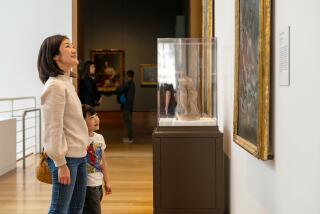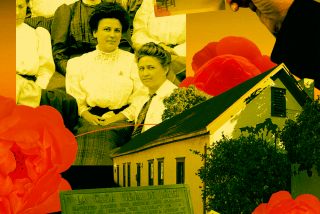Rancho Los Alamitos unveils wealth of Southern California history
“Mother About to Wash Her Sleepy Child” by Mary Cassatt is a hallmark of the Los Angeles County Museum of Art’s collection. Warm and fuzzily familiar yet strikingly modern, the 1880 painting has been admired by critics and the public alike since its arrival in Los Angeles 50 years ago — when the museum was still part of a multi-purpose institution in Exposition Park.
And where, you might wonder, did the artwork come from? Cassatt was an American Impressionist who spent much of her life in France, so it’s not surprising to learn that the painting belonged to collectors in both countries before going on the market at a New York gallery in 1945.
But did you know that from 1946 to 1962 the Cassatt resided at Rancho Los Alamitos, a historic cattle ranch in Long Beach? Florence Bixby, the lady of the ranch from 1898 until her death in 1961, bought the oil-on-canvas work and bequeathed it to the museum, which she served as a trustee.
That’s one of many little known facts about Rancho Los Alamitos. To visit the 7.5-acre site, deeded to the city of Long Beach in 1968 and run by a private foundation, is to go on a sort of treasure hunt through Southern California history. The ranch itself is the first revelation. Greatly reduced from its original sprawl, it’s tucked away in a gated residential community.
But Long Beach’s secret is now out. The rancho reopened this week after an $8.5-million project that includes restoration of the ranch’s barnyard area and construction of a 13,000-square-foot education facility called the Rancho Center as an addition to the horse barn.
“It’s a coming out party,” Executive Director Pamela Seager says. Although the ranch has been open for years, its restoration signals a more visible commitment to public education and historic preservation.
The goal, says Claudia Jurmain, director of special projects and publications, was to create “a sense of home and place” in a microcosm of Southern California history, “where visitors don’t feel like visitors.”
Anyone who strolls around the buildings and grounds will discover Italian ceramic panels from the Della Robbia family studio hanging on courtyard walls, a blacksmith plying his trade near the barns and two enormous Moreton Bay fig trees, planted around 1888, framing a gracious, 18-room residence that began as a rudimentary adobe shelter.
To get a historical overview of all this, the place to start is the Rancho Center. Jurmain and William S. Wells have designed an exhibition, “Rancho Los Alamitos — Ever Changing, Always the Same,” to tell the story of the ranch in human terms.
Native American workers, Belgian tenant farmers, Chinese immigrants, Mexican ranch hands and Japanese lease farmers, as well as their bosses, are represented in photographs, letters and oral histories. A large map painted on the floor of a multi-purpose room shows the scope of the original ranch and how it was divided over time. Murals of native and “newcomer” plants, enlarged from watercolors by the late illustrator Dugald Stermer, cover walls of the light-filled room.
The earliest known inhabitants of the area were native Tongva people whose descendants consider the surviving ranch a sacred site. Its relatively modern history began in 1790, when Spanish soldier Jose Manuel Perez Nieto received a 300,000-acre tract known as Los Coyotes as payment for service on a California expedition. Nieto lost about half of his holding a few years later and in 1833 his heirs split the remaining property into five ranches. Nieto’s eldest son, Juan Jose, received a 28,500-acre parcel called Rancho Los Alamitos (Ranch of the Little Cottonwoods) and sold it to Jose Figueroa, the Mexican governor of the territory, for $500.
Next, in 1842, came Abel Stearns, an enterprising New Englander who moved to Los Angeles and bought the ranch and its livestock from Figueroa’s estate for $1,500. Floods and droughts decimated Stearns’ cattle in the early 1860s, leading to the foreclosure of the ranch in 1865.
The Bixbys entered the picture in 1878, when John William Bixby arrived from Maine. He and two partners purchased the ranch in 1881 for $125,000 and began to develop outlying parts. In 1911, when his son, Frederick, became the owner of Rancho Los Alamitos, it consisted of 3,600 acres. Ten years later, an oil strike on the property brought great wealth to Frederick Bixby and his wife, Florence, but the ranch continued to shrink.
The Bixbys’ oil fortune provided plenty of funds for Florence to plant gardens, enhance the house and buy artworks. In the 1920s and ‘30s, she hired leading landscape architects — the Olmsted brothers, Paul J. Howard, William Hertrich, Florence Yoch and Allen Chickering — to create four acres of distinctive gardens.
The Olmsteds’ “Friendly Garden,” for example, grew from family friends’ botanical gifts. “Playdays,” a bronze nymph by Harriet Frishmuth — an American student of French sculptor Auguste Rodin — was the garden’s original centerpiece, but it’s now on view in the ranch house, along with Rookwood Pottery that formerly adorned an outdoor fountain.
The Cassatt and a small painting of water lilies by Claude Monet, also given to LACMA, are represented by reproductions in the music room. Nearby, above a fireplace, is “The Fancy Dress,” a 1926 painting by American Impressionist Frederick Frieseke, purchased at his studio in France. Some members of Florence’s family judged the acquisition “too fancy and too Frenchy,” Seager says, but it reflects her quest for an artful environment.
Native American baskets, molded glass works and a signature nighttime cowboy scene by American painter Frank Tenney Johnson are displayed in other rooms.
Thanks to Bixby family members and sharp-eyed supporters, more than 90% of the original artworks, furnishings and garden ornaments are on the site, Seager says. A long-lost metal sign made for Rancho Los Alamitos Office turned up in a Berkeley antique shop and is back where it belongs, hanging on a post outside the office.
Seager, a former director of the California Historical Society, came to the ranch in 1985 to set up the foundation’s partnership with the city and stayed to write a highly detailed master plan. Faced with the challenge of carrying it out, she offered to make a 10-year commitment to the project if the foundation’s board president, Preston B. Hotchkis, would do so too.
“We’re both still here,” she says. “We have implemented 165 of 167 recommendations.” They include relocating five agricultural structures that had been moved from their original sites. Next on the list: seismic strengthening of the ranch house and restoration of the “Old Garden,” thought to have originated in the 1840s.
Mimi Morris is executive director of the California Cultural and Historical Endowment, a state fund that awarded the foundation a $1.5-million grant. “We have many great projects,” Morris says, referring to a program that has given about 150 organizations a total of $122.5 million. “What I love about this one is that it encapsulates so much of California’s history.”
Seager hopes the restored ranch will “connect with new immigrants and show that we all lived together in one place. Before, when you came to the site, what you saw was the last owner,” she says. “We wanted to bring in everybody from Native American times to the end of World War II, the people who lived here and shaped it, and show changes of the landscape over time.”
More to Read
The biggest entertainment stories
Get our big stories about Hollywood, film, television, music, arts, culture and more right in your inbox as soon as they publish.
You may occasionally receive promotional content from the Los Angeles Times.






